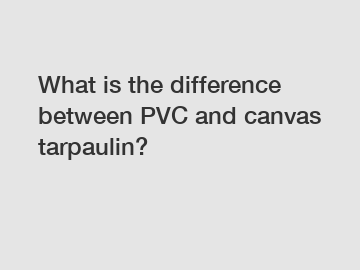What is the difference between PVC and canvas tarpaulin?
Link to Rondy
When it comes to choosing the right type of tarpaulin for your outdoor protection needs, it's important to understand the key differences between PVC and canvas materials. Both have their own set of advantages and disadvantages, so being informed can help you make the best decision for your specific situation.
PVC (polyvinyl chloride) tarps are made from a synthetic material that is highly durable and resistant to various weather conditions. These tarps are typically waterproof, making them ideal for protecting your belongings from rain, snow, and other forms of moisture. PVC tarps are also UV-resistant, which means they won't break down or deteriorate when exposed to sunlight for long periods of time.

Canvas tarps, on the other hand, are made from a natural material that is breathable and more environmentally friendly. While canvas tarps may not be as waterproof as PVC tarps, they are still highly water-resistant and can provide adequate protection for your belongings in most situations. Canvas tarps are also more resistant to tears and punctures, making them a good choice for long-term use in rugged environments.
One of the main differences between PVC and canvas tarps is their weight and flexibility. PVC tarps are typically heavier and less flexible than canvas tarps, which can make them more difficult to handle and transport. Canvas tarps, on the other hand, are lighter and more pliable, making them easier to maneuver and store when not in use.
In terms of maintenance, PVC tarps are generally easier to clean and maintain than canvas tarps. PVC tarps can be simply wiped down with a damp cloth or hosed off with water to remove dirt and debris. Canvas tarps, on the other hand, may require more thorough cleaning with soap and water to remove stains and mildew.
When it comes to cost, PVC tarps are typically more expensive than canvas tarps due to the synthetic materials used in their production. However, the durability and longevity of PVC tarps can make them a cost-effective investment in the long run, especially if you require heavy-duty protection for your belongings.
In terms of versatility, both PVC and canvas tarps can be used for a variety of purposes, including covering vehicles, equipment, and outdoor furniture. PVC tarps are often used for industrial and commercial applications where maximum protection is required, while canvas tarps are popular for recreational activities such as camping and boating.
Ultimately, the choice between PVC and canvas tarps will depend on your specific needs and preferences. If you require maximum protection and durability, PVC tarps may be the best option for you. If you prefer a more environmentally friendly and breathable material, canvas tarps may be the better choice.
Regardless of your decision, it's important to properly care for and maintain your tarpaulin to ensure it continues to provide adequate protection for your belongings. Regularly inspecting your tarp for tears, punctures, and other signs of wear and tear can help prevent damage and prolong its lifespan.
In conclusion, PVC and canvas tarps each have their own unique set of advantages and disadvantages. By understanding the key differences between the two materials, you can make an informed decision on which type of tarpaulin is best suited for your outdoor protection needs. Whether you choose PVC or canvas, investing in a high-quality tarpaulin can provide peace of mind knowing your belongings are safe and secure from the elements.
Are you interested in learning more about Bulk Fiberglass Mesh? Contact us today to secure an expert consultation!

Comments
0